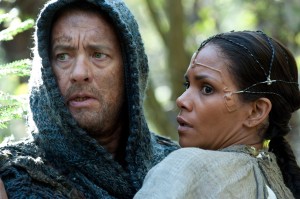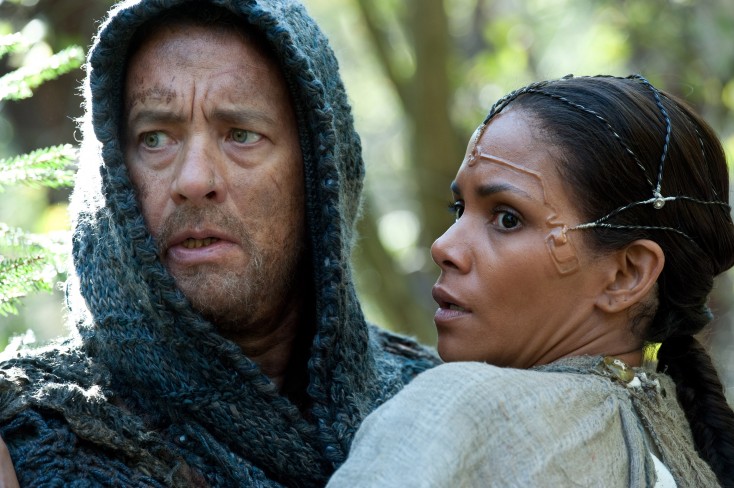
(L-r) TOM HANKS as Zachry and HALLE BERRY as Meronym in the epic drama “CLOUD ATLAS.” ©Warner Bros. Entertainment.
By JAMES DAWSON
Front Row Features Film Critic
The dazzling, multi-plotline “Cloud Atlas” is a shuffle-play cinematic carousel with a half-dozen horses of very different colors. Each of the movie’s six connected stories within its 500-year timeline is glimpsed briefly and destined to come around again soon, but in shifting positions that reveal new aspects with every turn.
That peek-a-boo structure is a triumph of technique over storytelling by directors/screenwriters Tom Tykwer (“Ron Lola Run,” “The International”) and Lana and Andy Wachowski (“The Matrix” trilogy, “Speed Racer”). Their impressive job of interweaving the six unique stories from the less audaciously entangled novel by David Mitchell makes even those segments that might be weak stuff on their own tolerable.
The 1800s seagoing tale of a would-be abolitionist, a 1970s San Francisco investigative reporter mystery and a present-day British nursing home farce are interlaced with more imaginative segments about a manipulative composer’s assistant in 1930s Scotland, a 22nd-century videogame-violent Korean dystopia and a far-future Hawaiian fantasy. That hopscotching means there’s never a good time to head for the bathroom, because nothing seems to stay onscreen for long even though the movie clocks in at nearly three hours.
Several actors pop up in more than one story in different roles, sometimes changing their sex or race. Tom Hanks is a duplicitous, thieving poisoner in the past, a murderous Cockney gangster in the present and a primitively superstitious villager in the distant future. Halle Berry is the wife of an aging and amoral composer in the 1930s, a reporter on the trail of nuclear-industry corruption in the 1970s and a member of a technologically advanced civilization a few centuries hence. Jim Broadbent is a cruel ship’s captain in the 1800s, the early 19th-century Scottish composer and a shady publisher on the run from creditors in the present.
What’s impressive is how well Tykwer and the Wachowskis are able to juggle all of those plots and cleverly segue from one to the next while keeping nearly everything accessible. Themes of soul migration, an unlikely messiah and a possible nirvana tie the movie together without overwhelming it. Don’t worry that this will be an indecipherable metaphysical mess like Darren Aronofsky’s “The Fountain,” in other words.
Having said that, the “Cloud Atlas” segment that takes place after an apparent nuclear apocalypse is the most troublesome, making-sense-wise. As a tattooed native with visions of a chatty and threatening death spirit, Hanks speaks in a nearly unintelligible semi-Jamaican dialect that could have used subtitles, if not a glossary. It’s also not entirely clear what exactly happens on a technical level at the end of that bit, even if the gist seems obvious.
Other story-spanning stars who play multiple characters include Ben Whishaw (primarily as the 1930s writer of the “Cloud Atlas Sextet” symphony), Jim Sturgess (mainly as the conscience-stricken attorney-turned-abolitionist) and Doona Bae (most notably as a genetically engineered “fabricant” in 2144 Neo Seoul who becomes part of a very “Matrix”-like high-caliber SF adventure).
Not everything here works, especially the broad comedy of the old-age home segment. But the movie as a whole is so intriguingly constructed and confidently ambitious it’s a must-see experience.
Also, be sure to stay through the end credits to see how many characters each actor embodied—several of which are sure to come as a surprise.





